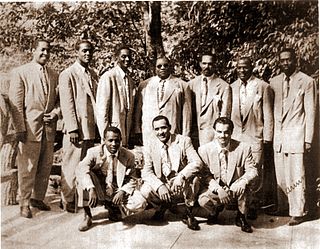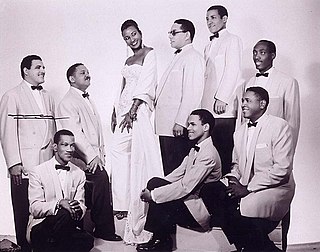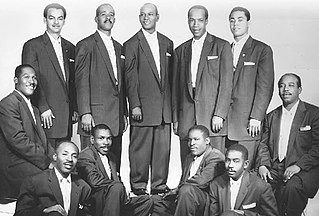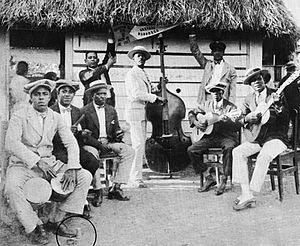The term conjunto refers to several types of small musical ensembles present in different Latin American musical traditions, mainly in Mexico and Cuba. While Mexican conjuntos play styles such as norteño and tejano, Cuban conjuntos specialize in the son, as well as its derivations such as salsa.
Son montuno is a subgenre of son cubano developed by Arsenio Rodríguez in the 1940s. Although son montuno had previously referred to the sones played in the mountains of eastern Cuba, Arsenio repurposed the term to denote a highly sophisticated approach to the genre in which the montuno section contained complex horn arrangements. He also incorporated piano solos and often subverted the structure of songs by starting with the montuno in a cyclic fashion. For his approach, Arsenio had to expand the existing septeto ensemble into the conjunto format which became the norm in the 1940s alongside big bands. Arsenio's developments eventually served as the template for the development of genres such as salsa, songo and timba.

Arsenio Rodríguez was a Cuban musician, composer and bandleader. He played the tres, as well as the tumbadora, and he specialized in son, rumba and other Afro-Cuban music styles. In the 1940s and 1950s Rodríguez established the conjunto format and contributed to the development of the son montuno, the basic template of modern-day salsa. He claimed to be the true creator of the mambo and was an important as well as a prolific composer who wrote nearly two hundred songs.

Bongos are an Afro-Cuban percussion instrument consisting of a pair of small open bottomed hand drums of different sizes. The pair consists of the larger hembra and the smaller macho, which are joined by a wooden bridge. They are played with both hands and usually held between the legs, although in some cases, as in classical music, they may be played with sticks or mounted on stands.
Son cubano is a genre of music and dance that originated in the highlands of eastern Cuba during the late 19th century. It is a syncretic genre that blends elements of Spanish and African origin. Among its fundamental Hispanic components are the vocal style, lyrical metre and the primacy of the tres, derived from the Spanish guitar. On the other hand, its characteristic clave rhythm, call and response structure and percussion section are all rooted in traditions of Bantu origin.

La Sonora Matancera is a Cuban band that played Latin American urban popular dance music. Founded in 1924 and led for more than five decades by guitarist, vocalist, composer, and producer Rogelio Martínez, musicologists consider it an icon of this type of music. Notable singers to have sung and recorded with the band include Bienvenido Granda, Daniel Santos, Myrta Silva, Miguelito Valdés, Leo Marini, Celia Cruz, Nelson Pinedo, Vicentico Valdés, Estanislao "Laíto" Sureda, Alberto Beltrán, Carlos Argentino, and Celio González.
José Marcelino Díaz Marquetti, better known as Cheo Marquetti, was a renowned Cuban son vocalist and songwriter.

The guayo or ralladera is a metal scraper used as a percussion instrument in traditional styles of Cuban music such as changüí, predecessor of son cubano. Largely replaced by the güiro during the 20th century, the guayo is now rare. In the Dominican Republic, the güira, a similar metal scraper used in merengue, is sometimes called guayo. In contrast to Cuba, güiras replaced güiros in the early 20th century.
Early Cuban bands played popular music for dances and theatres during the period 1780–1930. During this period Cuban music became creolized, and its European and African origins gradually changed to become genuinely Cuban. Instrumentation and music continually developed during this period. The information listed here is in date order, and comes from whatever records survive to the present day.

Alfredo Boloña Jiménez was a Cuban guitarist who played a role in the early development of the son as director of the Sexteto Boloña.
Abelardo Barroso Dargeles was a Cuban bandleader and singer, the first sonero mayor to be recognized as such by the Cuban public.

Gilberto Oviedo la Portilla, better known as Papi Oviedo, was a Cuban tres player.
Luis Martínez Griñán, better known as Lilí Martínez, was a Cuban pianist, arranger and composer specializing in the son montuno style. He played in the Conjunto de Arsenio Rodríguez and Conjunto Chappottín. Together with Rubén González and Peruchín, he is said to have "forged the style of modem Cuban piano playing in the 1940s".

Félix Chappottín was a Cuban trumpeter and bandleader. He was a member of three highly successful Cuban bands: Septeto Habanero, Arsenio Rodríguez's conjunto and Conjunto Chappottín, which he directed.

Isaac Oviedo was a Cuban tres player, singer and songwriter. He was the founder and leader of the Septeto Matancero for over 50 years, and the author of many famous sones such as "Engancha carretero". Throughout his long career Oviedo only recorded a handful of sessions, mostly for American record labels. He has been called "one of the greatest Cuban tres players" by other musicians such as Efraín Ríos and Pancho Amat. According to the latter, Oviedo was the pioneering and most influential tresero of the septeto format. His technical innovations include the alzapúa thumb stroke and the use of the pinky finger.

Terceto Yoyo was a Cuban son trio active during the 1920s. It was formed by Heliodoro "Yoyo" Rodríguez (güiro), Jesús "Chuchú" Arístola (marímbula) and Celedonio Hernández (guitar). They recorded up to twenty songs for Victor in Havana, enjoying great popularity at the time, although only three of their recordings have survived. These are considered the oldest son recordings featuring the marímbula, together with those by the Sexteto Habanero.
Magín Díaz García was a Colombian musician and composer. He is best known for performing traditional music from the Caribbean coast of Colombia and for composing several popular songs. He is particularly remembered for his chalupa version of the Cuban son "Rosa, qué linda eres", first recorded by the Sexteto Habanero Godínez in 1918, which has become a standard of the Colombian repertoire. Between 2012 and 2017, he released three solo albums, the last of which, El Orisha de la Rosa, was awarded a Grammy Award.
Enrique Raúl Planas Fernández was a popular Cuban singer and songwriter. He performed and recorded with many bands and musicians, including Carlos Barbería y su Orquesta Kubavana, Sonora Matancera, Celia Cruz, Conjunto Rumbavana, Conjunto Chappottín, Charanga Rubalcaba, Rubén González, and the Afro-Cuban All Stars.

"Suavecito" is a Cuban son written by Ignacio Piñeiro and first recorded by his Septeto Nacional in 1929. It is a standard of the son repertoire and one of the biggest hits by the Septeto Nacional. It has been covered by numerous artists including Cuarteto Machín, Celia Cruz, Orquesta Aragón and Sierra Maestra.

"Sandunguera" is a bolero written by Marcelino Guerra and Luis Piedra for Arsenio Rodríguez in 1943. Arsenio's version, however, was arranged as an uptempo guaracha and released as the B-side of Pablo Cairo's "Sin tu querer" by RCA Victor. The song has since been covered by multiple artists, including Marcelino Guerra himself, and has been called a "classic track" and an important recording in the development of Arsenio's career.












